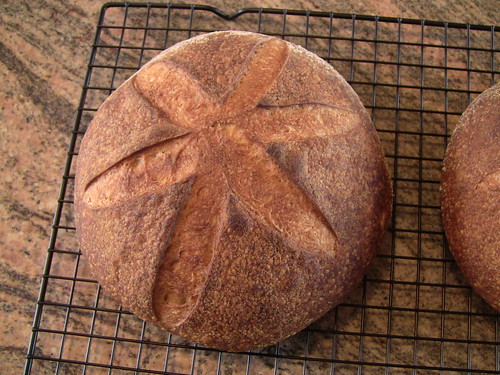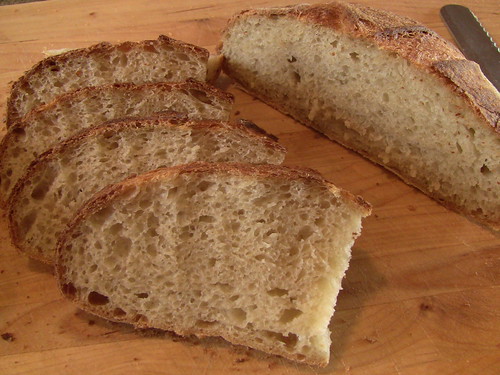Saturday 1/15/11. Today, I am musing on my bread-ucation. Sort of a milepost marking. I have been baking for five months. But I am beginning to feel somewhat knowledgeable about a narrow category of breads, due in large part to (1) The Fresh Loaf and readings recommended here and advice given here, and (2) an enthusiasm for baking that has me making lots of bread as often as I can. I learn stuff every time I handle dough and bake bread.
In that short span of baking experience, here are some things I've learned about baking simple sourdough breads:
- To make bread the way you like it takes lots of study and gathering of general information (reading, watching videos, asking questions, and the like) and even more hands-on trial and error (the error part is very important). It's good to know some bread science--what factors have what results and why--but you can only improve your bread-baking by keeping track of what you do each time and making adjustments the next time.
- You may like bread to be a certain way that others don't, and your tastes may change. Some like big holes in the crumb, others don't; some like really dark crusts, others don't; some like sourer flavor than others do, etc. Make it the way you like it and be your own judge.
- There are lots of variables that affect the crust, crumb and flavor: to name a few: flour choices; hydration; attributes of your starter culture; dough handling at each stage (including mixing, kneading and/or folding, dividing, pre-shaping, shaping, scoring and loading); time of each stage; temperature of ingredients; temperature of environment; type, quality and duration of steam during the bake; characteristics of the oven; attention to, understanding of, and reaction to the sensory information the dough provides; and luck, blessedness, karma, whatever you choose to call it. All of these variables are important, but I think the last two in the list are the most important.
- There is no perfect loaf. Striving for improvement can yield improvement, but can also yield higher expectations. The Earth is round; the horizon keeps receding.
- The more I learn, the more I realize how little I know.
- Bread tastes better when it's been well photographed and shared, and your friends ooh and ahh at it.
This weekend, I am making San Francisco Sourdough from Reinhart's Crust and Crumb. This is the first time I have made something called "San Francisco Sourdough". I have made 20 or 30 sourdough breads, mostly variations on Hamelman's Vermont Sourdough (including Brother David's San Joaquin and my own San Francisco Country). But I love the sour flavor, the crispy crust and the moist, chewy crumb of classic San Francisco Sourdough, and I've lived in San Francisco and environs for most of my life. So isn't it time?
I have read the formula and all the commentary in the book, and I've looked at several TFL blog posts on this bread. What I learned: my brother David really likes this bread (or at least he did in 2008-09 when he blogged many times about it). I chose the formula from Crust and Crumb because (1) I have the book, (2) the formula won some whoop-de-doo award, (3) my brother David really likes this bread and he has good taste, and (4) it's a weekend when I can focus on this formula which takes several days of attention.
In comparison with most of the other sourdoughs I've made, this formula calls for a firmer starter, considerable kneading, and a more passive fermentation approach. There are no stretch and folds during the long (4 hour) primary ferment. I am also--for the first time--making a sourdough with all white flour, and no rye or whole wheat. I am using BRM enriched white flour, made--according to the bag--from high gluten hard red wheat.
I can't say I am following Professor Reinhart's formula exactly (I rarely follow anything exactly). I made a liquid starter from my stock starter, and let it ripen, then chill (but not as long as the formula prescribes). I then made a firm starter from the liquid starter, and let it ripen, then chill (but not as long as the formula prescribes). I suspect the shortened retardation time on the starters will make the bread less sour than it would have been, but I will get to finish the process in time to enjoy the bread before the end of the weekend. Some day I will give this formula all the time it asks, and see if the result is sourer or otherwise different.
I mixed the firm starter, flour, water and salt with my fingers and a plastic scraper. At least 90% of the dough ended up in the bowl at the end of the mixing. I then kneaded it on my granite counter, sprinkled with flour. What I learned. I like kneading dough (I sort of knew that from a few past kneading experiences); it gives immediate visual and tactile feedback on dough development. Unlike stretching and folding over several hours, when you knead dough, you feel the strengthening of the gluten with every few turns. Also, I like kneading on floured granite. Seems like just the right amount of sticky friction. The dough is now fermenting. Giving me time to muse. What I learned as I mused and watched the activity in my sunny courtyard: voles and sparrows will riotously gorge themselves on scattered birdseed, while totally ignoring each other. The sparrows will chase each other away, but the sparrows don't even seem to acknowledge the voles, and vice versa.
Later 1/1/5/11. I have now shaped the 1 pound dough pieces into boules. What I learned. This dough is loose and silky though the hydration is fairly low. Is it because the gluten develops less strength when the dough is not stretched and folded periodically? Or because the all white flour absorbs less water than my usual dough which has 15-25% whole grain? Or because the fermentation (and looseness) is enhanced by the high proportion of stiff levain? I also learned that un-floured granite is an excellent surface for using the boule shaping technique that Brother David has famously video-recorded. I strove for a really taut sheath, but the little blobs seem to think they're 75% water when they're more like 60%.
Now the boules are in their bannetons in their plastic bags, proofing. They will proof in the kitchen until they have once-and-a-halfled (half a doubling). Then they will go in the refrigerator for the night.
Sunday 1/16/11. 90 minutes after being taken out of the refrigerator, the boules were gently flopped from their bannetons onto pieces of parchment, then placed on a cookie sheet and scored. The oven, with baking stone, was pre-heated at 475 F for an hour steamed using Sylvia's magic towels and a cast iron skillet with lava rocks. In addition, contrary to my usual procedure, I misted the loaves with water when they were loaded and again after a couple minutes. After 15 minutes, I removed the steaming apparati and reduced the temperature to 425 F on convection setting. After 30 minutes total (and a 207 F internal loaf temperature), I turned the oven off and left the loaves on the stone with the door ajar for another 10 minutes.
The oven spring was very good, though not the mighty spring of some other sourdoughs I've baked. The loaf scored with a star rose about 20% more than the one with the hash mark (is this a commentary on telephone keypads?). The crust is perfectly colored, deep caramel and quite even, shiny, with little crust bubbles here and there. What I learned. Spritzing loaves seems to add to shine and crust bubbles. The star scoring pattern seems to encourage upward spring. Convection baking (in a good oven) seems to enhance evenness of crust color. I love my North Coast oven.


As the loaves cool, I can take a few minutes to look off to sea, where a large group of grey whales are commuting South, presumably looking for real Wharf Bread. They are spouting off and waving hello with their flukes.
Later 1/16/11. The loaves are mostly cooled. They spray crust crumbs widely as they are sliced. The crumb is moist, airy but chewy. Very much a classic SF sourdough. The holes are mostly small, with a few bigger pockets, but not what you'd call an open crumb. This is just as I like it. The flavor is simple but good. Mildly sour. What I learned. Maybe the longer retardation of the starters is key to stronger sourness. The less open crumb may be linked to the passive bulk retardation (with no stretch-and-folds and thus less gluten strength to hold bigger bubbles).


Update: An hour later, the structure of the crumb has solidified and become a bit denser. I'd say medium dense. Good texture. The flavor's also become a bit more sour.
All in all, this is a bread I'll make again, probably adding some stretch-and-folds and some whole grains. And definitely trying the longer retardation of the starters that the recipe calls for. That would combine the more complex flavors, more gluten strength and the sourness I'm seeking. I learned a lot from this bake.
Glenn